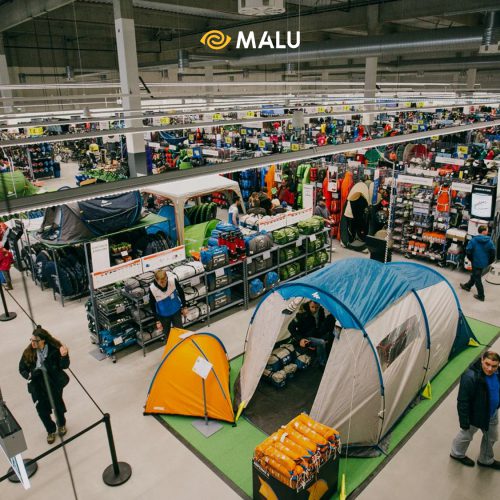
When you work in a small or “not yet” professional environment, you may find that we don’t talk about too many technical terms or that much of what we do is based on feelings and experience.
However, if you want to go further in your career path or access great environments, the terms or ‘expert knowledge’ plays an important role.
In the article below, Malu would like to send you an article that summarizes and analyzes the professional branding terms that you need to master to have strategies as well as to build and develop a strong corporate brand. .
Tip: Use the keyboard shortcut Ctrl + f (⌘ + f on a Mac) to quickly find the term you want to know.
Brand term (rhymes A – B)
Awareness – Brand awareness :
Indicates the amount of people or target market that may be aware of the existence of a company or brand that already exists in the market.
Usually, people usually divide into two types of recognition:
- Top of mind, through which it is possible to measure the percentage of people who mention a brand randomly as soon as they are asked to list several brands in a certain product category.
- Suggested Perception – this measures the percentage of people who can identify a brand of a certain product when a list of brands is presented for them to choose from.
Brand – Brand :
A mixture of tangible and intangible characteristics expressed through the symbols of a brand and, if managed properly, can create value and influence. for that brand.
The term “brand equity” has many different expressions and interpretations: For example, according to marketers and consumers, brand equity is the promise and delivery of experiences about a brand. certain brand; For businesses, the value of a brand is the guarantee of future income streams of that brand; From a legal point of view, value is a separate array of intellectual property.
Brands offer their customers a means of choice and stimulate recognition in concentrated markets.
Brand Architecture – Brand structure :
The way an organization organizes and lists its brands in a catalog of many different brands. There are actually three types of brand structure systems including:
- Pure Master Brand: Use a single parent brand name for all of the company’s services and products.
- The second is the type of Sponsorship Brand, in which all sub-brands are associated with the parent brand of the business through advertising images, naming …
- And the last category is the Independent Branding type, in which the brands of a single business operate solely with the parent brand and each product or service is promoted its own brands in distinct ways. in its target markets.
Brand Associations – Brand associations:
These are the feelings, beliefs, and understandings of a brand that a customer or consumer is aware of.
This brand association comes from the customer’s experiences with that brand, is consistent with and consistent with the brand positioning and must be made on a differentiated basis.
Brand Commitment – Commitment to a brand:
A customer’s level of commitment to a particular brand, ensuring that they will continue to use or purchase products of this brand in the future.
The level of commitment indicates how secure a business’s customers will stay with it instead of following other direct competitors.
Brand Earnings – Brand Earnings:
These are the cash flows or any other source of income that is believed to bring the brand to any company that owns it.
Brand Equity – Brand equity :
Defined as all of the most salient features or qualities of a brand, resulting from the interaction of groups of interests with the brand, thereby creating commitment from individuals and creating demand for the company’s branded products.
It is these very different thoughts and feelings that make the brand valuable and attractive to customers.
Brand Equity Protection :
The implementation of strategies to reduce the risks and associated liabilities of legal action for reasons such as counterfeiting, deviation or plagiarism, and trademark theft or other related factors. related to the brand, to maintain positive thoughts and feelings from consumers and customers, making the brand valuable to them in the long run.
Brand Essence ( Intrinsic nature of the brand ):
The promises or commitments that a brand expresses in the simplest terms with a single purpose.
For example, the Volvo brand is often associated with “safety”, AA is emergency service… But the strongest intrinsic qualities of a brand must be rooted in the most basic needs. of cutomer.
Brand Experience – Brand experiences:
The way in which a brand is created with its interest groups in mind.
Some of these experiences are controlled by factors such as retail environment, advertising, services, products or websites… Others are uncontrollable such as comments from the press and recommendations from customers themselves.
Strong brands often emerge when there is a full convergence of unified experiences, combining the above factors to create a brand that customers have a clear and distinguishing experience from other brands. .
Brand Extension – Brand Extension :
It is the development of other values of a brand that can bring the brand to entirely new markets.
Brand Harmonisation – Brand Harmonization:
The concept is to ensure that all products within a given brand range have a proper name, image and above all be properly positioned in various markets in different regions. different geographical areas.
Brand Identity – Brand Identity :
The external expression of a brand, including its name and images.
Brand portraits are the most basic ways in which consumers can recognize and differentiate a business’s brand from those of its competitors.
Brand Image – Brand image :
Is everything that customers get out of a brand.
For users, brand image is mainly determined based on the actual experiences that a product or service of a brand brings and how it meets the needs and expectations of customers. row; For those who do not use products or services, the image of a brand depends entirely on impressions, attitudes and beliefs that have not been verified with complete and authentic information.
Brand Licensing – Franchising:
The owner of a trademark authorizes another party to use the trademark they own. Usually, in exchange for the right to use the trademark, the rental company must pay the leasing company a fee similar to the trademark royalties.
Brand Management – Brand management :
In fact, this process involves managing both tangible and intangible aspects of a brand.
For brands of products, the tangible part is also the products themselves such as packaging, price, etc.
As for service brands, the tangible part is done at the same time as the customer’s own experience of the retail environment, direct communication with salespeople, and overall customer satisfaction. Surname. The other intangible factors are the same, all are the emotional connection with customers, this factor comes from experiences, interactions with brand personality and people. Therefore, these intangible brand values must be managed through the main application of brand characteristics, employee communication skills and human factors.
Brand Parity – The parity between brands:
A measure of the degree of similarity or difference between different brands in the same product category under consideration. The degree of parity between brands varies by product type.
For the petroleum industry it is very high – more than 80% of respondents said they do not see much difference between brands in this industry. In contrast, brand parity seems to be very low in the auto industry as more than 75% of interviewees said there is a lot of difference between brands in this industry.
Brand Personality – Brand personality :
Similar to human personality traits such as seriousness, warmth, etc., is an association for a brand as a person, personifying the brand to achieve differentiation.
Usually, the personality of a brand is carried out through long-term advertising with high budget, investment in image and packaging that match the tastes of customers. And brand personality is also communicated through a brand’s behaviors such as both packaging and customer communication by employees who will represent a business’s brand to customers.
Brand Platform – Brand Platform: Includes the following key elements:
- Brand Vision : Insights that guide customers into the world of the brand.
- Brand Mission – Brand Mission : Is how a brand will act on the planned vision.
- Brand Values : What a brand depends on to survive. These values serve as a benchmark for measuring behavior and performance.
- Brand Personality : The characteristics of a brand identity.
- Brand Tone of Voice – Brand Voice : How the brand communicates to the audience.
- Brand Positioning : Determining the unique position a brand occupies in a competitive business environment, to ensure that customers can distinguish its brand from other brands. other brands. Brand positioning involves carefully applying all elements of the Marketing Mix to effectively differentiate the brand in the minds of customers.
Brand Strategy – Brand Strategy :
A plan to systematically develop a brand so that it can meet agreed objectives.
These brand strategies must be rooted in the brand’s mission and must be driven by the principle of differentiation and the ability to attract long-term customers. Brand strategy must influence the activities of a business to ensure consistent behaviors and experiences among customers with a brand.
Brand Valuation – Brand Valuation:
The process of identifying and measuring the economic benefits of brand equity that result from ownership of that brand.
Branding – Branding :
Select and mix tangible and intangible characteristics to differentiate products and services; or a combination of all activities, motivating and appealing to customers.
Brand term (CDEF rhyme)
Co-branding : The
combination of two or more brand names to assist in the introduction and launch of a new product, service or venture.
Consumer Product – Consumer products :
Defined as products or services intended for consumption, use by individuals or to meet the needs of members of a household.
Core Competencies – Core competitiveness :
A concept related to the skills and abilities of a company in the fields, thereby contributing to the best competitiveness for the company against other competitors.
Corporate Identity – Portrait/identity of the organization:
To some extent an organization’s portrait is often associated with a company’s iconic features such as a logo or signature, etc., but is also commonly used to refer to the way a company presents itself to its interest groups or is also seen as a means to differentiate it from the rest of the company in the perception of its customers.
Counterfeiting – Counterfeit goods, imitation goods:
When any organization or individual produces a product that looks like a previously branded product, packaged and presented in a manner intended to mislead customers.
Country of Origin – Country of origin of the product:
The country in which the product is manufactured. Customers’ attitudes and support for a product are often strongly influenced by factors such as the location where the product is designed and manufactured.
Customer Characteristics – Customer characteristics:
Includes all features that are distinctive, distinctive, distinguishable, and dominant, and other characteristics used in market segmentation to differentiate between groups of customers.
Customer Relationship Management (CRM) – Customer relationship management:
Customer Relationship Management: The practice of closely monitoring customer behavior to develop relationship-building processes and marketing programs that engage customers with a company’s brand.
Customer management is also concerned with the development of software or systems that offer personalized relationships and services that are unique to each customer.
Customer Service – Customer Service :
The way in which a brand responds to the needs of its customers through a variety of channels, such as over the phone, or Internet services in the case of remote banking services, or as the use of online banking services. employees in the case of the retail and entertainment industries to satisfy their customers.
Demographics – Demographics:
The description of external characteristics of a group of people such as age, gender, nationality, marital status, education level, occupation or income.
Based on the above descriptions, it is common to make decisions in market segmentation based on demographic data.
Differential Product Advantage – Product differentiation advantage:
It is a product that possesses a feature of high value to the customer that other similar products do not have.
Differentiation
It is the company’s creation and demonstration of unique characteristics in a product, service or brand compared to other products, services or brands.
Differentiator – Points that make a difference:
It is any tangible or intangible feature that can be used to distinguish a product or a company from other products or companies.
Diversion – Deviation :
This happens when a mainstream product is sold to a buyer in one market or distribution channel, and then the product is sold to another market or distribution channel to take advantage of the situation. price differences without the consent of authority holders such as brand owners.
In addition, this definition is also applied to bi-trade, “grey market and activities taking place in gray market”.
Endorsed brand – Guaranteed brand : (See section Brand Architecture)
Often, the brand name of a product or service backed by another parent brand can create prominence, as in the case of the Tesco Metro brand, or have a relatively minor impact, as in the case of the Tesco Metro brand. in the brand name of Nestle Kit-Kat products.
FMCG (Fast moving consumer goods) – Fast moving consumer goods :
A term used to describe a variety of consumer products that are frequently purchased, such as food, cleaning products, or toiletries.
Focus Group – Focus Group:
A qualitative research method in which a group of about eight people is invited to a location to discuss a given topic, such as a topic about feature-packed handheld tools.
Using this focus group method will make the discussion more lively and more inclusive. Qualitative groups allow researchers to look deeper into areas of interest (for example, the nature of a brand’s commitment). And the results of the above research method give new richer textures of a database, and thereby draw a trend or more general observations.
This method is sometimes called group discussion.
Freestanding Brand – Independent Brand: See section Brand Architecture
The name of a brand and its attributes used for a single product or service in a product category without any reference to the brand name or product characteristics. other.
Functionality – Product functionality:
What a product can bring benefits and uses to the user and what customers can manipulate with that product.
Brand term (rhyme GHIP)
Goods – Goods:
Only one product, including outstanding tangible values. For almost all goods, however, it also exists in tandem with intangible values to a greater or lesser extent, as the case may be.
Group Discussion (Xem Focus Group):
High Technology (High tech) – High technology :
Is a term used with general meanings and can be applied widely in many fields, such as electronics, data technology, communication, medical technology and biochemistry…
To be classified as a high-tech company, there is a clear definition of the applicable criteria: the company must have at least 35% of its employees with a technical degree and must use at least 15% of revenue invested in R&D activities.
Another definition that also applies is that a company must hire twice as many scientists and engineers and invest twice as much in research and development activities as all the other companies. other domestic manufacturing companies.
Intangibles “Intangible” – Invisible :
That is, it is impossible to touch
- Intangible assets : Tangible assets such as: Trademarks, copyrights or copyrights, patents, rights to preserve designs, proprietary business knowledge, databases, etc.
- Intangible brand attributes : Intangible brand attributes such as: brand name, symbol-logo, images, color, shape and taste. (See Service Brands section.)
Packaging Design – Packaging Design :
Packaging design, design formats as well as image system to identify brand products.
Parent Brand – Parent Brand :
A brand can support one or more sub-brands in the same category.
Passing Off – Activities to protect intellectual property rights:
Legal activities to protect the interests of a particular business or brand.
More specifically, actions to combat the abuse of customers’ trust and confidence in existing brands.
Perceptual Mapping Graphic – Competitive analysis chart:
Used to analyze and interpret how your potential customers rate your products and services compared to other competitors.
Most rating charts often show two aspects at the same time, for example, one axis represents price, the other shows quality. There are also some charts that can show multiple aspects on different axes.
Positioning Statement – Positioning Statement:
Descriptions of desired positioning characteristics of products and brands that businesses want their target customers to recognize and distinguish.
Power Brand – Strong Brand :
The strategy is to give each product in the business line its own advantages and strengths without the need for support from parent brands or other brands.
A strong brand strategy is a strategy to exploit internal resources so that brands and products can exist and be legally protected. This strategy is mainly used in the consumer goods industry. Unilever and Procter&Gamble’s are experts in developing strong brands.
Product Brand – Brand :
A name associated with a brand with specific uses. For example, Comfort fabric softener.
Rebrand – Re-branding :
When businesses want to rebrand, the product is based on new internal and external factors.
The repositioning is done after careful preparation of identity and market in order to bring new vitality to products and brands.
Relative market share – Correlation market share:
The difference in market share between the business and its competitors.
The large market share will take advantage of the advantages of scale in product development, production as well as marketing activities. It also helps you inculcate the image of your brand in the minds of customers, in addition to having an advantage when we implement pricing strategies.
Relaunch – Re-promotion:
Bringing products back into specific markets.
This activity is because the business used to promote and sell products but stopped in the past, and now it has reappeared.
Product re-promotion usually doesn’t change much about the product. For example, there will be some technical adjustments, repositioning, and the product will be distributed to other channels or repositioned.
Repositioning – Repositioning:
Communication activities help bring new positions to existing products in the minds of customers and capture potential markets.
A lot of potential products but still hold the leading role in a faint way because it has not been properly positioned to its potential. And the repositioning is completely reasonable if the business wants to affirm the core values of the brand.
Rollout – Expanding the market :
The process by which a company introduces new products or services to different markets or different customer segments.
Selective Media – Selective Media:
Unlike Mass Media, Selective Media only targets a small and separate audience, individual customer groups are divided by geographical factors, demographics, psychological information (also known as social media). targeted communications), such as those specifically for individuals with an income of $10,000/month or more.
Service Brand – Service Brand:
A product contains intangible values.
“ Service is something you buy and sell but cannot touch ” (According to The Economist magazine).
In this respect, a service is something you do for someone or a promise you will bring it to them.
Share of Mind – Awareness level:
There are many definitions of this concept today, but they all have one thing in common: The Share of Mind Index measures how often customers think about a certain brand as a percentage of the total number of customers. brands in the same industry or product branch.
To make it easier to understand, Share of Mind is made possible by market research done for the brand. If market share measures brand coverage and size in the market, Share of Mind is an indicator to measure the depth of the brand in the minds of customers.
Share of Voice – Media correlation :
Shows the correlation between the company’s media spending compared to competitors in the industry.
Sub-brand – Sub-brand :
Products and services have their own names and unique brand identities to be distinguishable from similar brands of the same company, such as Unilever’s Clear and Sunsil.
Tangibles – Tangibles:
Tangible assets are assets such as manufacturing plants, machinery and equipment, cash, etc. Tangible elements of a brand include products and packaging.
The tangible value of the product is the benefits of the product that are experienced and recognized by the user.
Target Market – Target Market :
The market segment or customer group that the company aims to serve, is the direction of marketing activities.
Top of Mind:
In today’s multi-product market, is your product and brand the first thing that customers always think of?
In market research tables, Top-of-Mind is the first name when asked about the rewards that respondents know about a certain category. Top-of-Mind is the highest level of Share of Mind.
To achieve Top-of-Mind position, businesses often must have a large enough media coverage in their industry.
Trademark – Commercial Copyright :
Registered signs are used to identify and distinguish products and services from similar products and are protected by law.
Trademark Infringement – Copyright theft:
Unlawful use by a business of registered commercial copyrights, or that have similarities with registered copyrights.
Trendsetter – Trendsetter :
Characters or events that do not follow the usual ways and achieve breakthrough successes.
iMac is an example of a trend in design when today’s office suppliers all share the common colors and designs of an iMac.
User Segmentation – Customer Segmentation :
The division of potential customer groups based on how and for what purpose they use their products.
For example, baking powder can both be used for cooking and can be used to clean teeth, cooking oil can smooth hair or fry food, so what benefits do customers use the product?
Visual Identity – Visual identity :
Brand image, including parts such as logos, wording and layout, packaging, and packaging.
Epilogue
Hope the above article has helped you gain new knowledge about the most common terms in Brand – Brand. Read more articles about Brands at Malu’s Blog




